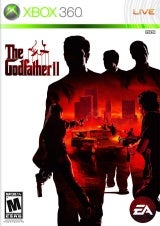Sonny Corleone was a hothead who shot first and never bothered asking questions. His intentions were good but his implementation sucked. His brother Michael, on the other hand, was a man who thought through everything and paid attention to details. He never pulled a gun unless he was going to use it, and when he did, he hit what he aimed at. That's why Michael ended up as the Godfather and Sonny ended up in a pool of blood on the New Jersey Turnpike. As Michael himself might say, "Ideas are good but execution is everything." That brings us to The Godfather II, a game built around a great idea that ends up being more Sonny than Michael.
The Godfather II loosely follows the storyline of the classic Francis Ford Coppola crime drama. Beginning in the late 1950s, the player assumes the role of Dominic, underboss of the New York branch of the Corleone crime family. The tutorial segment follows Michael and Hyman Roth's attempt to ally with the Batista government in Cuba, which gets cut short by Castro's revolution. In the process, the boss of the New York family is gunned down, leaving the player as the new Don. From there it falls to the player to rebuild the Corleone interests in New York, Miami and eventually Cuba in an effort to put the Corleones back on top of the underworld.
The storyline summary also outlines The Godfather II's best idea -- putting the player in the shoes of the Don and letting them run their crime family as they see fit. By using a "Don's View," a sort of pseudo-strategic overview of the game's three cities, players can get a complete outline on what sorts of rackets, crime rings and businesses are available, who owns them, how well they're protected by guards and more. The player as Don can hire and fire guards, assign defenders from within his own crew of "Made" guys to stop enemy takeovers, or send those same guys on their own to take over enemy operations. This view also tracks "Favors" such as contract hits, burglaries, beatdowns and the like that the player can do for special one-use abilities such as calling off the cops or rebuilding a bombed-out business. The game's narrative is used mostly as a guide for the player toward building their empire.
In between managing the family business, the player spends most of their time running around on foot and in cars in classic Grand Theft Auto style, doing things like knocking over banks, intimidating shopkeepers, taking over rackets, burglarizing government offices and assassinating rival family members. This section of the game is again fine in theory. There's an undeniably fun element to the first few New York missions when you're learning what it takes to be a Don. Hit a crime racket and use the left trigger auto targeting and a variety of fun weapons ranging from a .357 Magnum to a Molotov cocktail to kill the place's guards. Then use the Blackhand melee combat system to intimidate the owner into cutting you in on the action by finding their weak points. Some will be vulnerable to punches, grabs, being threatened with tossing off the roof, or simple property damage. The moment after I took over my first crime ring was awesome and I thought that I had finally found the strategy gamers' GTA clone.
It doesn't take too long after those first few missions, though, to realize that there are more holes in Godfather II's gameplay than there were in Sonny Corleone's body. To start, the game is just too bloody easy. The decision to give Dominic and his buddies regenerating health makes every fight a simple exercise in letting your friends act as meat shields while you pick off bad guys with ridiculous ease. While there is a cover system, there's never a reason to use it for anything other than massed fire by the oh-so-stupid enemies. The rest of the time I found myself blithely walking around firefights soaking up bullets and trying to remember which weapon executions I hadn't performed yet so I could get the achievement for doing all of them.





 Poor
Poor


